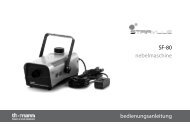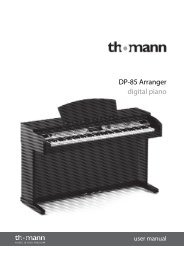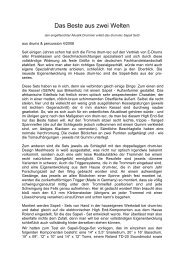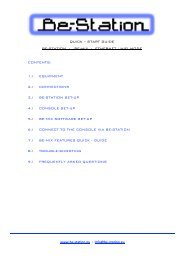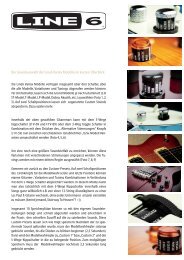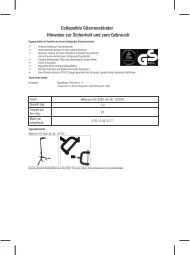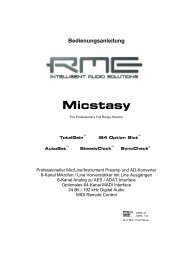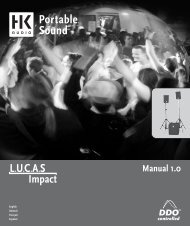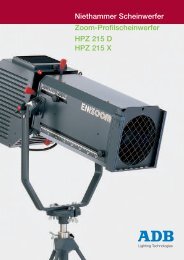Create successful ePaper yourself
Turn your PDF publications into a flip-book with our unique Google optimized e-Paper software.
11:5 Programming patterns<br />
A guide to drum pattern programming is beyond the scope of this manual - like good melody and harmony parts, there are no<br />
shortcuts to good drum composition! However, here are a few hints and tips to point you in the right direction.<br />
Drumming fundamentals<br />
Consider how a drummer would play a pattern. Most drummers have 2 hands and 2 feet: 4 limbs in total. It therefore logically<br />
follows that generally, up to 4 things can be played at any one time. It’s good to watch a few drumming videos (a good source of<br />
these can be found at drummerworld.com) or study some drum scores to get a better idea of how drum patterns are composed.<br />
Study a few points of drumming rudiments: things like single and double strokes, paradiddles, and so on. Understanding how<br />
drummers build rhythms is vitally important in creating realistic drum parts.<br />
Physical interfacing with the computer<br />
Drumming is a very physical activity! It’s good to play something in real time to capture real spontaneity and groove, instead of using<br />
a mouse on a piano roll.<br />
A keyboard action is not ideal for drumming, as there is a lot of travel required to trigger the note. Keyboard mechanisms were<br />
designed to move hammers that hit strings, not to play drum sounds! It’s better to use something more tactile and responsive like<br />
a drum-pad unit (such as the M-Audio Trigger Finger, Korg PadKontrol, Akai MPD-16/24 etc) or an electronic drum kit.<br />
Transcribe, study and edit existing drum parts<br />
Try to transcribe the drum parts from your favourite records. If you find it difficult to program drums that you can hear with your<br />
ears, then it’s unreasonable to expect yourself to program drums that you can only hear ‘in your head’. The more you practice<br />
drum programming techniques, the more skills you learn. A good way to transcribe a pattern is to import a looping segment of a<br />
song into a track on your sequencer. While looping the part, program the drum sounds until it sounds right, then mute the loop.<br />
Whatever remains should be a reasonable approximation of the drums.<br />
Another valuable resource for study is BFD2’s library of Grooves. Even if the patterns in the Groove library aren’t your cup of tea,<br />
you can study them as MIDI parts in your sequencer to see how a drummer pushes and pulls against the ‘grid’ of hard beat divisions.<br />
It’s also a good idea to look at the event velocities, to get a feel for how accenting and velocity variation can help the feel of<br />
a drum pattern.<br />
If you like the feel of a Groove or a Fill but not the actual pattern, it’s very easy to to create new patterns by moving notes ‘up and<br />
down’ to different kit-piece articulations in your sequencer’s piano roll or in BFD2’s Groove editor. Many sequencers also contain<br />
tools for ‘groove quantizing’ – extracting the feel from a MIDI part (such as an exported Groove) and using it as a quantize template<br />
for other MIDI parts. See your sequencing host’s manual for details of such features.<br />
1



